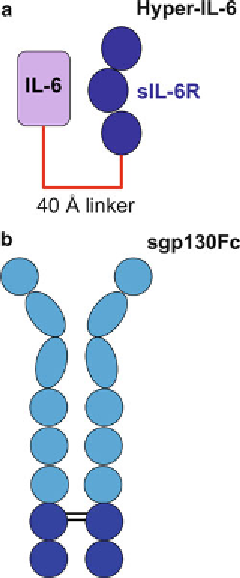Biology Reference
In-Depth Information
Fig. 2
Designer cytokines for the analysis of IL-6 classic- and trans-signaling.
(
a
) IL-6 was fused to the sIL-6R by a flexible peptide linker. This designer cytokine
was called Hyper-IL-6. (
b
) The extracellular portion of gp130 was fused to the
constant portion of a human IgG1 generating the fusion protein sgp130Fc
trans-signaling via sIL-6R (
41
). A fusion protein of sgp130 with
human IgG1 (sgp130Fc) (Fig.
2b
) was shown to be about ten
times more efficient than monomeric sgp130 in blocking IL-6
trans-signaling (
41
). Sgp130Fc was used as a molecular tool to
discriminate between classic and trans-signaling in vitro and in vivo
(Fig.
3
). It was demonstrated in animal models of rheumatoid
arthritis (
42-44
), peritonitis (
45
), sepsis (
46, 47
), inflammatory
bowel disease (
48, 49
), inflammatory colonic cancer (
50-52
),
ovarian cancer (
53
), and pancreatic cancer (
54
) that the blockade
of IL-6 trans-signaling was sufficient to block the progression of
the disease (Fig.
3
). This has led to the concept that IL-6 trans-
signaling is an emergency reaction which is not needed in everyday
life, but which is switched on in situations of cellular or tissue stress
(
8, 55
). On the other hand, IL-6 classic signaling has been shown
to be needed for the acute phase protein expression in the liver
(
56
) and for the regeneration of intestinal epithelial cells upon
wounding (
57, 58
).

Search WWH ::

Custom Search